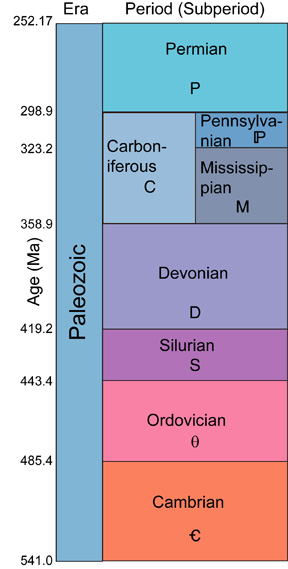


Phanerozoic Eon: 542 - 0 Ma
Paleogeography and Geology of the
Silurian:
Huge reef complexes in many parts of the
world. In fact, the Silurian and Devonian see the largest volume of metazoan-generated carbonates in Earth's history.
Global oceanic highstand after the big terminal Ordovician regression
In Appalachian Orogen of Laurentia, late flysch and molasse from the Taconic Orogeny, Appalachians erode down to base, resumption of stable margin (carbonate and sandstone) deposits.
In the foreland basin and mid-craton of Laurentia, reefs so big that they allowed evaporation of water in the middle of the basin.
Paleogeography and Geology of the
Devonian:
Extremely warm conditions worldwide: evaporites common North and South of 30º.
Continued widespread tabulate-stromatoporoid reef complexes around the world.
In eastern Laurentia, the Taconic Appalachians had worn all the way down by the beginning of the Devonian. No longer molasse deposits, but instead once again stable platform deposits (Helderberg Group, Oriskany Sandstone, etc.).
Collision of Laurentia, eastern Avalonia, and Baltica to form Laurussia (sometimes called Euramerica):
In northern Laurentia, Ellesmere Orogeny (possible collision with one of the Asian blocks)
In western Laurentia, the first of the Cordilleran orogenies:
Towards end of Devonian, CO2 levels begin to drop:
Major mass extinction event in Late Devonian
To Next Lecture.
To Previous Lecture.
To Syllabus.